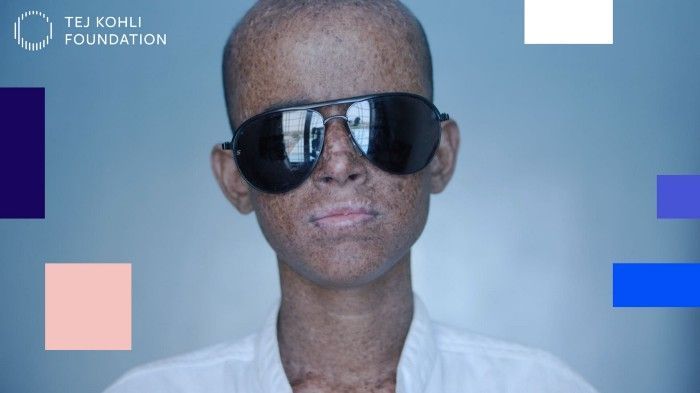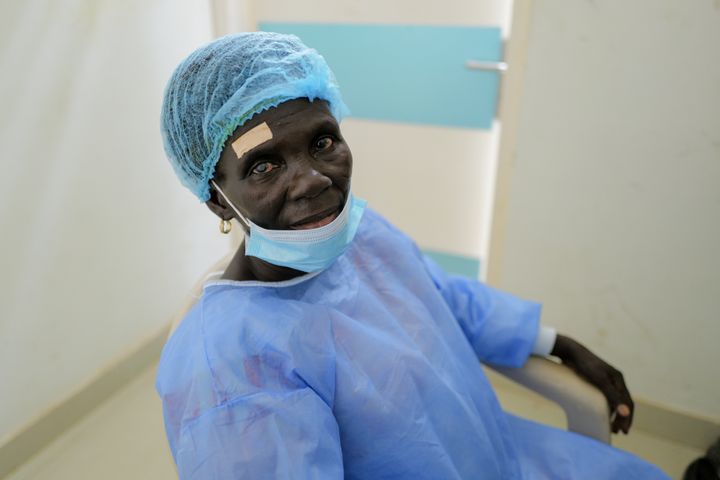Tej Kohli: India’s Forgotten XP Children

At 8PM BST today documentary film ‘Father Will I See Again?’ will premiere online on YouTube at: https://www.youtube.com/watch?v=inf9z3p0Dis. The film reveals how corneal transplants are bringing hope to those living in the shadows with Xeroderma Pigmentosum, a rare genetic condition which causes the skin to burn and take on a blistering and scaly appearance. The film follows brother and sister Ameer and Sadiya, who live in a poor urban area on the outskirts of Hyderabad in India, as they complete treatment to have their vision restored so that they can return to their education again.
During the last twelve months, the ‘Father Will I See Again?’ documentary short has toured and been screened at film festivals all over the world to great acclaim, and has won several awards and accolades including a ‘Platinum Award’ at the Independent Shorts Awards. This exposure has elevated awareness and understanding of the under-reported plight of young people in poor communities who must endure XP without the life-extending health and social care support that they would receive in more affluent countries.
SOCIAL IMPACT ENTERTAINMENT
Far from being a commercial venture, ‘Father Will I See Again?’ is an example of social impact entertainment, a growing movement that works to engage audiences with issues and to emotionally influence them to become part of making a change. The documentary seeks to highlight the plight of children in India living with Xeroderma pigmentosum (XP), a rare genetic condition.
Many of these children are forced to live their lives in the shadows and face significant social stigma. An absence of clinical knowledge and specialist care services in many underserved communities rob young XP sufferers of their prospects. The physical effects of the condition also include corneal blindness.
“Our hope is that we’ve made a film that strongly portrays the everyday struggle that young people in developing countries with visual impairment go through. We want the audience to feel for Ameer and Sadiya and to be left with an understanding of the problems they face” – Fred Burns, Co-Director, Father Will I See Again?
The XP ‘Impact Initiative’ by the Tej Kohli Foundation sought to highlight the plight of India’s XP children through a series of high-profile collaborations. Working with internationally renowned photographer Simon Townsley and the Global Health section of The Telegraph, the Tej Kohli Foundation first brought the realities of life of Indian children with XP visibly to the fore in a major photographic study and news feature. This culminated in the independent documentary short about XP, which premiered at the 2020 Manchester International Film Festival before touring film festivals worldwide to raise awareness.
“The sun is usually a symbol of life, of happiness and positivity but we see an opposing image in this film. It is so harmful that siblings Ameer and Sadiya need to hide from it, they have to cover themselves up to go out and are told to play in the shadows. This informed the film’s visual style, to use light sparingly, streaming through curtains and hallways but leaving the majority of the compositions in darkness” — Daniel Grasskamp, Co-Director, Father Will I See Again?
XERODERMA PIGMENTOSUM
Xeroderma pigmentosum (XP) is a rare genetic condition that makes the sun’s rays lethal. It is estimated that up to one in 370 Indians suffers from XP — one of the highest incidences of the condition anywhere in the world. Despite its prevalence in India, there is still an enormous stigma with sufferers shunned as people believe they are cursed. Fear around the disease is compounded by the unknown; sufferers usually stay indoors in order to avoid UV ray exposure.
Without treatment, half of those with the condition contract skin cancer by the time they turn 10. Around a third of those with XP also suffer from a range of debilitating nervous system conditions including difficulty walking, decreased intellectual function and seizures. Within poor and underserved communities where sufferers do not have access to adequate treatment, the life expectancy for a young person with XP is a little over 30 years old.
Blindness is also endemic among those with XP as the front covering of the eye, the cornea becomes increasingly damaged with exposure to the sun. Few Indian children with the condition finish school because of their deteriorating eyesight. Without qualifications and unable to venture out into the sunlight and at the mercy of their communities, they typically spend their days hidden away inside family homes.
AMEER AND SADIYA
‘Father Will I See Again?’ tells the story of Siblings Ameer (14) and Sadiya (12) Hamza, who both suffer from Xeroderma Pigmentosum (XP). They live in Jeedimetla, a poor urban community on the outskirts of Hyderabad in India. The local urban community in Jeedimetla is mostly comprised of families from poorer backgrounds who are working and aspiring towards the lower middle classes of India.
Ameer and Sadiya are in many ways typical of most young teenagers. They have many friends. Ameer loves cricket and playing with smartphones. He is an extrovert who avoids doing household chores and dreams of one day becoming a pilot. Younger sister Sadiya is quiet and sensitive and prefers to stay inside to play with her dolls and practice reading.
A typical day for the Hamza family starts early, especially during Ramadan, when the family rises early for Sehri before fasting through the day until Iftar and then dinner at around 18:45. After dinner the family might typically be found huddled around their television.
But life is not easy for a family with two children living with XP. Paying for treatments and buying medicines is expensive, and a few years ago the family had to sell all of their jewellery to pay for treatment for Ameer and Sadiya.
Despite both living with challenging symptoms of XP and deteriorating eyesight, Ameer and Sadiya have a relationship that is typical of any teenage brother and sister. They fight a lot, but also have a strong bond, and Ameer is very protective of Sadiya. Due to their condition, they are mostly unable to leave the house, so they often play together inside.
Sadiya is the sensible one: she follows all instructions precisely and is very careful to ensure that her skin isn’t affected by the sun and that her eyes don’t suffer. Ameer by contrast is cheeky and naughty, and often ignores his parents’ warnings and goes outside unprotected.
Sadiya feels great sadness about her XP. She wants to be ‘normal’ but knows that she is not like most other young girls. Ameer questions if he will ever get better, and although he is active, there are moments when he questions why he too is not like other boys his age.
XP AND CORNEAL BLINDNESS
At birth, Ameer did not show any symptoms. But over time and through exposure to sunlight, his parents realised that something was wrong. At just 18 months old his parents first discovered strange spots under Ameer’s eyes. They first assumed it was an allergy, and so for some time treated the spots with balms and oils, but the damage had already been done to his cornea, which became opaque.
“It was not a good feeling to know that the skin problem turned out to be a problem for the eyes too. When children tease him, he returns home and he asks me…father, will I see again? I tell him don’t worry my son, you will be able to see. If God is willing you will get your vision back” — Amir & Sadiya’s Father
As the spots kept growing, Ameer’s father took him to Mumbai and then Lucknow to see skin specialists — a costly trip far beyond the financial means of the family. Initially, Ameer received treatment for his skin, but by the age of eight, his eyes started turning red and then white, and his vision started becoming seriously impaired.
Not being able to play in the sun also creates a lot of restrictions for Ameera and Sadiya, compounded by the prejudice that Ameer and Sadiya face as a consequence of their physical appearance. They used to enjoy going to school, where their classmates were extremely supportive, but they stopped attending school because their deteriorating eyesight made it impossible to learn in a classroom.
“Sadiya studied up to class 7, but she is not studying as from next year. She is very good at her studies. She wanted to become a physician. I told her to study. I will do whatever possible from my end. I wanted to get my children educated. But God wishes differently. We have some agricultural land in our village. Maybe we will sell it and support her studies” — Sadiya’s Father
XP affects every part of the body, but the loss of eyesight is particularly pervasive. Scarring of the cornea over time makes vision opaque and foggy. With more severe scarring, the cornea becomes completely opaque, which then leads to tumours. The cornea can also become devoid of blood vessels, reducing moisture in the eye and culminating in a loss of vision that can only be corrected by a complete corneal transplant.
Ameer and Sadiya had developed severe vascularisation in their corneas, and full-thickness corneal scarring meant that they each needed corneal transplants for both eyes. Doctors were unable to come up with a solution and eventually referred Ameer to the specialists at the Tej Kohli Cornea Institute where Ameer and his sister Sadiya were handed a lifeline: the opportunity for life-changing cornea transplant operations funded by the Tej Kohli Foundation.
Ameer received his first cornea transplant for one eye in October 2018 and his second transplant for the other eye took place in May 2019. Soon his vision will be fully restored, and he hopes to soon start going back to school again. If Ameer and Sadiya had not received surgery before their cornea damage became permanent, they would have irreversibly lost their vision forever.
UNDERREPORTED
There are only a few studies into the prevalence of XP and very few recent ones. Up to one in 370 Indians suffer from XP. But there is underreporting because of a lack of awareness. There is also a social stigma attached to skin problems in India, and being a sunny tropical country, the high degree of sun exposure makes the visual symptoms of XP more pervasive and aggravates the degradation of ocular problems that lead to blindness. Many still believe the superstitions that skin conditions are a curse and so don’t seek medical help.
Still, sufferers in India have a long way to go both in terms of battling the serious health implications and crushing stigma. Stories like Ameer and Sadiya’s have led doctors at the Tej Kohli Cornea Institute to call upon the Indian government to make free cornea replacement surgery available across the country and ensure expert dermatologists are available in local hospitals.
By raising awareness of the little-known plight of India’s XP children amongst worldwide audiences at film festivals and now online too, my hope is that eventually more will be done to provide young sufferers of XP with free and unfettered access to healthcare and the resources that they need.
For more information on Tej Kohli as a philanthropist visit tejkohliruit.com and to read more of his views go to his Medium.
To read about Tej Kohli as an investor visit Kohli Ventures.
Find out more about Tej Kohli: Tej Kohli the technologist investing in human triumph, Tej Kohli the philanthropist trying to cure the developing world of cataracts and Tej Kohli the London tycoon with a generous streak.
| Follow: Twitter | Instagram | LinkedIn | Facebook | YouTube |




Comments ()